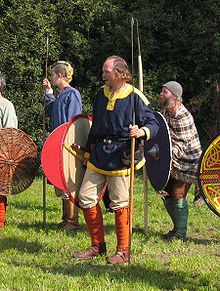
Back Ангон Byelorussian Angó (arma) Catalan Ango German Angón (arma) Spanish Angoo Estonian Angon French Angone Italian Angonas Lithuanian Angon Dutch Angon Polish

The angon (Medieval Greek ἄγγων, Old High German ango, Old English anga "hook, point, spike") is a type of javelin that was used during the Early Middle Ages by the Anglo-Saxons, Franks, Goths, and other Germanic peoples.[1] It was similar to, and probably derived from, the pilum used by the Roman army and had a barbed head and long narrow socket or shank made of iron mounted on a wooden haft.[1][2][3]
It was rare on the battlefield,[4] despite the claim by the Greek historian Agathias,[5] being found mostly in the grave goods of the wealthy.[4] The Fragmentary Chronicle of Saragossa credits an ango with killing King Amalaric of the Visigoths.[4] By the 7th century it had ceased to be used.[4] It also went out of fashion, together with other forms of throwing spears and javelins, in Francia, by the early 7th century.[6]
They are found in abundance in war graves in Illerup-Ådal, Denmark. They are also quite common in Norwegian graves from the Migration Era. In Finland, a local version of the weapon was popular during the Early Middle Ages.[7]
Although not very frequent in the Baltic countries, examples have also been found at various sites in Estonia, including burial sites at Sõrve and Hinniala.[8]
- ^ a b Halsall, Guy (2003). Warfare and Society in the Barbarian West, 450-900. London: Routledge. p. 164. ISBN 0-415-23939-7.
- ^ Blair, Claude; Tarassuk, Leonid, eds. (1982). The Complete Encyclopedia of Arms and Weapons. New York: Simon & Schuster. pp. 19–20. ISBN 0-671-42257-X.
- ^ Underwood, Richard (1999). Anglo-Saxon Weapons and Warfare. Stroud: Tempus Publishing. p. 24. ISBN 0-7524-1910-2.
- ^ a b c d Halsall, p. 165.
- ^ Histories 5.2.4–8.
- ^ Harrington, Sue. The Early Anglo-Saxon Kingdoms of Southern Britain AD 450-650: Beneath the Tribal Hidage. Oxbow Books (June 4, 2014). p. 201
- ^ Georg Haggren; Petri Halinen; Mika Lavento; Sami Raninen; Anna Wessman (2015). Muinaisuutemme jäljet. Helsinki. pp. 268–269. ISBN 978-952-495-363-4.
{{cite book}}: CS1 maint: location missing publisher (link) - ^ Tvauri, Andres (2012). The Migration Period, Pre-Viking Age, and Viking Age in Estonia. Tartu University Press. pp. 192-193. ISBN 978-9949-19-936-5.